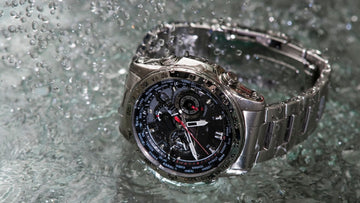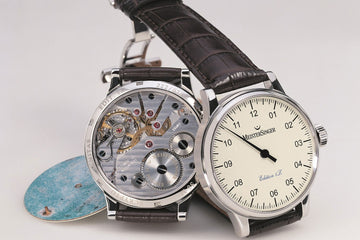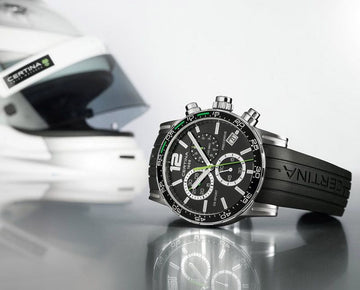Think your ‘50m water-resistant’ watch is swim-ready? Think again. Understanding water resistance in watches is crucial before you take your timepiece near the pool, shower, or ocean. Misreading the label can easily lead to water ingress, gasket damage, and costly repairs. This guide will break down what watch water resistance ratings actually mean, how to interpret them correctly, and how to choose the right watch for your needs.
Understanding Water Resistance in Watches
Water resistance refers to the level of protection a watch offers against water ingress. It is not the same as being waterproof. In fact, the term waterproof is misleading when applied to watches. Instead, manufacturers provide a water resistance rating, such as 30 meters or 10 ATM, indicating the degree of protection the watch offers under specific conditions.
A water resistance rating indicates how much static pressure the watch can withstand in lab conditions. This means the watch can be submerged in water at the given pressure, but only in controlled environments. Real-world activities create dynamic water pressure that often exceeds those controlled tests.
Understanding ATM, Meters, and Bar
- 1 ATM = 10 meters of depth = 1 Bar
- 3 ATM / 30 meters: Light water exposure only
- 10 ATM / 100 meters: Suitable for swimming
- 20 ATM / 200 meters: Suitable for diving
The atmospheric pressure at sea level is 1 ATM. If your watch is rated at 5 ATM, it can theoretically handle five times that pressure. However, different ratings mean different levels of water protection depending on your activity.
Watch Water Resistance Ratings Explained: Activity Chart & Safe Use
| Rating (ATM / Meters) | Suitable For | Avoid |
|---|---|---|
| 3 ATM / 30 meters | Dripping water, light rain, splashes | Submersion, showering |
| 5 ATM / 50 meters | Splashing water from any direction, quick rinse | Swimming, diving |
| 10 ATM / 100 meters | Swimming, snorkeling | Diving beyond recreational levels |
| 20 ATM / 200 meters | Water sports, recreational diving | Professional deep diving |
| 30 ATM / 300 meters | Professional diving watches | Technical saturation diving |
A higher number indicates a stronger level of durability. These water resistance ratings explained above are based on controlled lab tests, and real-world factors can reduce actual protection.
Why Watch Water Resistance Ratings Don’t Tell the Full Story
The ratings actually reflect what a watch can withstand under static conditions. But real-world usage involves movement, temperature changes, and wear. Diving into a pool creates more water pressure than static submersion. That’s why a watch that is suitable for swimming on paper may fail in actual use.
Key Limitations:
- Gasket wear: Over time, gaskets dry out or lose flexibility, reducing the level of protection.
- Button presses: Pressing pushers or unscrewing crowns while submerged in water may allow water to enter.
- Temperature shifts: Moving from hot environments to cold water affects the seal.
A rating ensures basic protection against water exposure, but maintenance and caution are critical.
How to Choose the Right Water Resistance Level for Your Watch
Let’s break down how to choose the right water resistance level based on your activity:
Daily Wear (3–5 ATM)
Ideal for office use, rain, and minor splashes. Dress watches often fall into this category. These are not suitable for swimming or bathing.
Recreational Use (5–10 ATM)
A rating like 10 ATM or 100 meters offers protection against water from swimming and snorkeling. These watches can withstand moderate water exposure.
Water Sports & Snorkeling (10–20 ATM)
For higher water pressure and water sports, go for 200 meters. These watches provide a higher IP rating, giving extra assurance for activities like surfing and kayaking.
Diving & Professional Use (20 ATM+)
Professional diving watches rated at 200 meters or more should meet ISO standards. These are engineered to withstand high water pressure and are ideal for harsh underwater conditions.
Water Resistance Care & Maintenance Tips
Proper care helps maintain the level of protection:
- Rinse after salt water exposure to prevent corrosion.
- Never operate buttons underwater.
- Always check the crown is secured before any contact with water.
- Pressure test your watch annually to ensure gasket integrity.
- Avoid hot showers, as the temperature and steam reduce resistance to water ingress.
Watches must also be kept clean to maintain breathability and resistance to corrosion, especially after exposure to moisture.
IP Ratings and Ingress Protection for Watches and Devices
Unlike ATM ratings, IP ratings are used across electronic devices. IP stands for Ingress Protection, and the IP standards are set by the International Electrotechnical Commission.
An IP rating consists of two numbers:
- First digit: Protection against solid particles like dust
- Second digit: Protection against liquid water
For example:
- IP67: Complete protection against dust and light water submersion
- IP68 rating: Offers higher water resistance and can be submerged in water longer
- IPX7: Protection against temporary submersion
The second digit in an IP rating is critical when considering contact with water. Higher IP ratings provide a greater degree of protection against moisture.
Use the IP ratings chart to compare devices. A specific IP like IP68 is recommended for swimming, while lower ratings such as IPX7 or IP67 may be suitable for accidental exposure to water.
Water Resistance Myths You Should Stop Believing
Myth: Waterproof means lifetime protection
- Fact: No watch is permanently waterproof. Water resistance decreases over time.
Myth: 30 meters means swimming is safe
- Fact: 30 meters only protects against light water. It is not suitable for swimming.
Myth: A high rating guarantees total safety
- Fact: Even dive watches need gasket checks and proper maintenance.
Myth: If it’s waterproof, I can ignore maintenance
- Fact: Gasket failure and wear reduce waterproof reliability over time.
FAQ: Watch Water Resistance
Q: What does watch water resistance rating actually mean?
A: It refers to the watch’s ability to resist water ingress at a specific pressure under lab conditions.
Q: Can I submerge a 5 ATM watch?
A: It may allow water to enter during swimming, depending on temperature and pressure.
Q: What is IP68?
A: A high ingress protection rating. IP68 is ideal for electronic devices exposed to liquid water.
Q: Are waterproof jackets really waterproof?
A: Jackets labeled waterproof must meet certain specifications to ensure a level of durability, but may still allow water to enter over time.
Q: How do I help you choose the right watch?
A: Review your activities like swimming, diving, or just daily use. Then select a watch with a level of water resistance that fits those needs.
Choose the Right Watch with Confidence
Understanding water resistance and how it works helps you avoid costly mistakes. Watch water resistance ratings vary widely, and it’s crucial to know what each rating indicates. Whether you’re selecting from our dive watches or stylish dress watches, always choose the right watch for your needs.
Watch water resistance is not a permanent condition. With proper care, timely servicing, and an awareness of what your rating offers, you can extend the life of your timepiece and maintain protection against water. For activities like swimming or water sports, select a model rated water resistant to at least 10 ATM or IP68.
Explore our full collection and use our filters to choose the right watch by water resistance rating.






